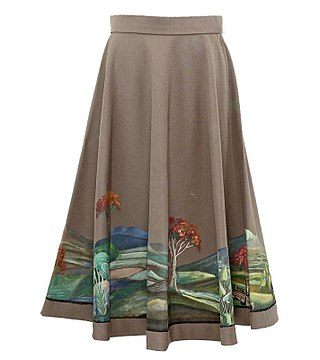
Yves Henri Donat Mathieu-Saint-Laurent, referred to as Yves Saint Laurent or YSL, was a French fashion designer who, in 1962, founded his eponymous fashion label. He is regarded as being among the foremost fashion designers of the twentieth century. In 1985, Caroline Milbank wrote, "The most consistently celebrated and influential designer of the past twenty-five years, Yves Saint Laurent can be credited with both spurring the couture's rise from its 1960s ashes and with finally rendering ready-to-wear reputable."

Christian Ernest Dior was a French fashion designer and founder of one of the world's top fashion houses, Christian Dior SE. His fashion houses are known all around the world, having gained prominence "on five continents in only a decade."

Karl Otto Lagerfeld was a German fashion designer.

A miniskirt is a skirt with its hemline well above the knees, generally at mid-thigh level, normally no longer than 10 cm (4 in) below the buttocks; and a dress with such a hemline is called a minidress or a miniskirt dress. A micro-miniskirt or microskirt is a miniskirt with its hemline at the upper thigh, at or just below crotch or underwear level.

A skirt is the lower part of a dress or a separate outer garment that covers a person from the waist downwards.

Count Hubert James Marcel Taffin de Givenchy was a French aristocrat and fashion designer who founded the luxury fashion and perfume house of Givenchy in 1952. He is famous for having designed much of the personal and professional wardrobe of Audrey Hepburn and clothing for Jacqueline Bouvier Kennedy. He was named to the International Best Dressed List Hall of Fame in 1970.

Valentino Clemente Ludovico Garavani, known mononymously as Valentino, is an Italian fashion designer, the founder of the Valentino brand and company. His main lines include Valentino, Valentino Garavani, Valentino Roma, and R.E.D. Valentino.

A cocktail dress is a dress suitable at semi-formal occasions, sometimes called cocktail parties, usually in the late afternoon, and usually with accessories.

Perry Edwin Ellis was an American fashion designer who founded his eponymous sportswear house in the mid-1970s. Ellis' influence on the fashion industry has been called "a huge turning point" because he introduced new patterns and proportions to a market which was dominated by more traditional men's clothing.

Manfred Thierry Mugler was a French fashion designer, creative director and creative adviser of Mugler. In the 1970s, Mugler launched his eponymous fashion house; and quickly rose to prominence in the following decades for his avant-garde, architectural, hyperfeminine and theatrical approach to haute couture. He was one of the first designers to champion diversity in his runway shows, which often tackled racism and ageism, and incorporated non-traditional models such as drag queens, porn stars, and transgender women. In 2002, he retired from the brand, and returned in 2013 as the creative adviser.

Emanuel Ungaro was a French fashion designer who founded the fashion house called the House of Emanuel Ungaro in 1965.

Fashion of the 1980s was characterized by a rejection of 1970s fashion. Punk fashion began as a reaction against both the hippie movement of the past decades and the materialist values of the current decade. The first half of the decade was relatively tame in comparison to the second half, which was when apparel became very bright and vivid in appearance.

Azzedine Alaïa was a Tunisian couturier and shoe designer, particularly successful beginning in the 1980s.

Fashion in the 1970s was about individuality. In the early 1970s, Vogue proclaimed "There are no rules in the fashion game now" due to overproduction flooding the market with cheap synthetic clothing. Common items included mini skirts, bell-bottoms popularized by hippies, vintage clothing from the 1950s and earlier, and the androgynous glam rock and disco styles that introduced platform shoes, bright colors, glitter, and satin.

Kenzō Takada was a Japanese fashion designer living in France. He founded Kenzo, a worldwide clothing brand, that also markets skin care and perfumes, Takada was the honorary president of the Asian Couture Federation.

Shoulder pads are a type of fabric-covered padding used in men's and women's clothing to give the wearer the illusion of having broader and less sloping shoulders. In the beginning, shoulder pads were shaped as a semicircle or small triangle and were stuffed with wool, cotton, or sawdust. They were positioned at the top of the sleeve to extend the shoulder line. A good example of this is their use in "leg o' mutton" sleeves or the smaller puffed sleeves which are based on styles from the 1890s. In men's styles, shoulder pads are often used in suits, jackets, and overcoats, usually sewn at the top of the shoulder and fastened between the lining and the outer fabric layer. In women's clothing, their inclusion depends on the fashion taste of the day. Although from a non-fashion point of view they are generally for people with narrow or sloping shoulders, there are also quite a few cases in which shoulder pads will be necessary for a suit or blazer in order to compensate for certain fabrics' natural properties, most notably suede blazers, due to the weight of the material. There are also periods when pads intended to exaggerate the width of the shoulders are favored. As such, they were popular additions to clothing during the 1930s and 1940s; the 1980s ; and the late 2000s to early 2010s.

In fashion, a sheath dress is a fitted, straight cut dress, often nipped at the waistline with no waist seam. When constructing the dress, the bodice and skirt are joined together by combining the skirt darts into one dart: this aligns the skirt darts with the bodice waist dart. The dress emphasizes the waist as its skirt portion is fitted. While the sheath dress can come in many patterns and lengths, it often is worn with short sleeves and reaches knee length.

Harem pants or harem trousers are baggy, long pants caught in at the ankle. Early on, the style was also called a harem skirt. The original so-called 'harem pants/skirts' were introduced to Western fashion by designers such as Paul Poiret around 1910, although they themselves were inspired by Middle East styles, and by şalvar. The term 'harem pants' subsequently became popular in the West as a generic term for baggy trousers caught in at the ankle that suggest the Turkish style, or similar styles such as bloomers, the South Asian shalwar and patiala salwar; the Bosnian dimije; sirwal ; and the Ukrainian sharovary.
Hervé Léger is a French fashion house that was founded by the designer Hervé Peugnet, who was also known as Hervé L. Leroux. As of 2023, the creative director is American designer Michelle Ochs.

A fashion boot is a boot worn for reasons of style or fashion. The term is usually applied to women's boots. Fashion boots come in a wide variety of styles, from ankle to thigh-length, and are used for casual, formal, and business attire. Although boots were a popular style of women's footwear in the 19th century, they were not recognized as a high fashion item until the 1960s. They became widely popular in the 1970s and have remained a staple of women's winter wardrobes since then.






















